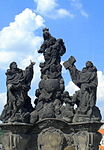Karlovy lázně
Electronic dance music venuesMusic venues in PragueNightclubs in Europe

Karlovy lázně (Czech pronunciation: [ˈkarlovɪ ˈlaːzɲɛ]; meaning "Charles' Spa") is a nightclub in Prague, Czech Republic, situated 50 meters from the eastern end of the Charles Bridge on the bank of the Vltava River. The building housing the club was a bath-house dating from the 14th century, and retains some original features, such as mosaic wall tiling and Roman spa-pools now used as dance floors. The club has five floors, with each floor playing a different style of music, a fact which features heavily in the club's marketing. Karlovy Lázně is the largest club in Prague, and claims to be the largest nightclub complex in Central Europe.
Excerpt from the Wikipedia article Karlovy lázně (License: CC BY-SA 3.0, Authors, Images).Karlovy lázně
Novotného lávka, Prague Old Town
Geographical coordinates (GPS) Address Nearby Places Show on map
Geographical coordinates (GPS)
| Latitude | Longitude |
|---|---|
| N 50.085469444444 ° | E 14.413775 ° |
Address
Novotného lávka 198/13
110 00 Prague, Old Town
Prague, Czechia
Open on Google Maps











